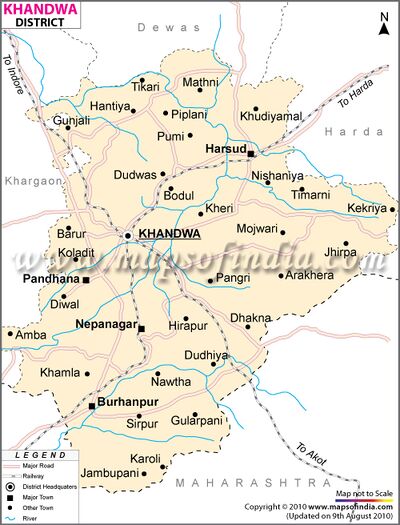East Nimar
(Redirected from Khandwa)
Jump to navigation
Jump to search
- For another village of same name see - Khandwa Niwai
East Nimar or Khandwa (खंडवा) is a tehsil and district in Madhya Pradesh.
Contents
Location
Khandwa District lies in the Nimar region, which includes the lower valley of the Narmada River. The Narmada forms part of the northern boundary of the district, and the Satpura Range form the southern boundary of the district. Burhanpur District, to the south, lies in the basin of the Tapti River. The pass through the Satpuras connecting Khandwa and Burhanpur is one of the main routes connecting northern and southern India, and the fortress of Asirgarh, which commands the pass, is known as the "Key to the Deccan". Betul and Harda districts lie to the east, Dewas District to the north, and Khargone District to the west.
Jat Gotras
Tahsils in Khandwa District
- Khandwa खण्डवा
- Pandhana पंधाना
- Harsud. हरसूद
- Punasa पुनासा
- Khalwa. खालवा
- Khandwa Nagar खण्डवा नगर
Villages in Khandwa tahsil
History
Notable persons
- Late B L Dhaka - Mob:9926013854
- Ajit Singh Patel- Thana Prabhari Mundi, Dist: Khandwa, Mob: 9425086166
- Hisalal Nathu ji jat- 9407455411
- Ramchandra Jat-milk dairy 6266548483
- Ashok Jat , milk dairy -- 9617680051
- Banshi lal Jat, milk dairy - 8959692764
- Moti Lal Jat , milk dairy- 8770509341
Gallery
External links
Source
- Santosh Kumar Thakur (Khenwar) 9826546968
References
Back to Madhya Pradesh

